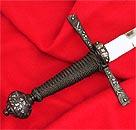 (swordplay part 2) the rapier is a slender double-edged sword that can be used to both cut and thrust. it is often accompanied by its sidekick, the dagger. just as our rapier-wielding hero is often accompanied by the character providing the comic relief in the movie. the sidekick is a vital tool- measured against his clumsiness the hero would always look more efficient. his rough, rustic simplicity makes the hero look suave and polished. his ungainly physique makes the hero look strong and athletic.
(swordplay part 2) the rapier is a slender double-edged sword that can be used to both cut and thrust. it is often accompanied by its sidekick, the dagger. just as our rapier-wielding hero is often accompanied by the character providing the comic relief in the movie. the sidekick is a vital tool- measured against his clumsiness the hero would always look more efficient. his rough, rustic simplicity makes the hero look suave and polished. his ungainly physique makes the hero look strong and athletic.this is a cinematic ploy, employed even today, to bolster the hero's persona. except, the hero has more than one sidekick now. these additional props are, perhaps, a sign of the times. of our growing incapacity to believe in heroes. and conversely, they also reflect on the inadequacy of the lead actors entering, or being thrust upon, the world of telugu cinema today. one can derive some minor consolation from the fact that tamil flicks , and telugu movies based on them, often use dozens of such props. consider, for instance, the horde of sideys crowding most of the scenes in basha.
coming back to the sidekick in the 'folk' movies: he also performs another crucial function in the movie. his unflinching loyalty and support make all the hero's exploits seem, somehow, right and justifiable. the hero's irresponsible philandering, his overreaching ambition, his unstated aversion to a normal vocation and his problems with authority are all pushed into the background by the sidekick's presence. in a way it's the sidekick who makes the hero!
let's consider the sidekick's personality: as characterization has never been one of telugu cinema's strong points, we have to build the character ourselves from whatever rudimentary details we can glean from the movie itself. let's look at his home and family- it is often left very vague and undefined. he's a hanger-on, his station in life is to hang around the hero and his home, why does the director need to dwell on his home and hearth? his roots, his growing years and the experiences that moulded him are all unimportant. in contrast, though placed in a workingman's family, the audience is never left in any doubt about the hero's noble antecedents. and his eventful infancy and childhood. and his family, stepmothers and brothers. and his guru... and other details of his life and and times.
what does this mean?
it means the filmmaker knows his pecking order. the hero's armed rebellion is not for any radical redistribution of power but to effect a transfer of authority from a reigning tyrant to a potential tyrant. the sidekick's role, as a member of the great unwashed, was to lend legitimacy to the hero's claim and not to put forth his own point of view. just as indian voters are expected to endorse one clan's claims over another and not to stake their own claim. therefore, the sidekick's roots are irrelevant, just as the roots of a majority of indian voters. is that also the reason why the 'period' any 'folk' movie is set in, always remains unstated? because the director is making a film on his own times? the sidekick is a mere rubber stamp. a cheering supporter (just as any indian voter) and not a partner. his stake in the fruits of the campaign the hero leads is nonexistent. revolution is a tea party, according to the director, but that does not mean everyone drinks from the same cups as you!
ten years after independence, that was the director's view on indian democracy.
i'll take a break here. before that, let me try to answer the question: why does the hero prefer the rapier? is it because he needs to flaunt it, frequently, in front of the heroine and her other suitors, to reinforce his claim? with its seeming suppleness and easy swing, the rapier is , perhaps, the best weapon to publicize his virility.
on the sidekick and other tools, later.



No comments:
Post a Comment